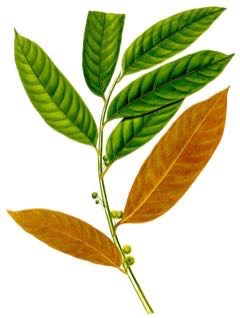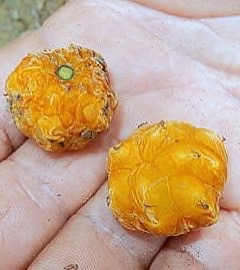 |
|
http://www.edibleplants.org |
 |
| Alex Popovkin wikimedia |
Translate this page:
Summary
Native to Brazil, Colombia, French Guiana, Guyana, Peru, and Suriname, Helicostylis tomentosa is an evergreen tree of up to 26 m in height with a straight and cylindrical trunk of up to 50 cm in diameter. The crown is narrow and elongated. The fruit is yellow and globose, with a delicious flavor. It is usually eaten raw. Medicinally, the bark is used as a remedy for stomach cramps and pain accompanying a high fever. Bark extracts have been pharmaceutically evaluated and are reported to show depressant effects on the central nervous system. The tree yields yellow latex. The wood is moderately heavy, durable, and resistant to insect attacks. It is easy to work and ideal for general construction, lathe work, and furniture.
Physical Characteristics

 Helicostylis tomentosa is an evergreen Tree growing to 20 m (65ft) by 20 m (65ft) at a medium rate.
Helicostylis tomentosa is an evergreen Tree growing to 20 m (65ft) by 20 m (65ft) at a medium rate.
See above for USDA hardiness. It is hardy to UK zone 10.
Suitable for: light (sandy), medium (loamy) and heavy (clay) soils and prefers well-drained soil. Suitable pH: mildly acid, neutral and basic (mildly alkaline) soils. It cannot grow in the shade. It prefers moist soil.
UK Hardiness Map
US Hardiness Map
Synonyms
Greeneina affinis (Steud. ex Tr?cul) Kuntze Greeneina poeppigiana (Mart.) Kuntze Helicostylis affini
Plant Habitats
Edible Uses
Edible Parts: Fruit
Edible Uses:
Fruit - raw. A delicious flavour[625 ]. The yellow, more or less globose fruit can be around 3cm in diameter[625 ].
References More on Edible Uses
Medicinal Uses
Plants For A Future can not take any responsibility for any adverse effects from the use of plants. Always seek advice from a professional before using a plant medicinally.
Febrifuge Hallucinogenic Stomachic
The red, milky sap from the bark is drunk as an hallucinogen in order to contact the spirits[348 ]. The rasped bark, mixed with alcohol, is used as a remedy for stomach cramps and pain accompanying a high fever[348 ]. Extracts prepared from the inner bark have been pharmacologically evaluated and are reported to elicit central nervous system depressant effects; and certain of the effects are described as being similar to those expected with Cannabis sativa. Because of the close taxonomic relationship of this species to Cannabis, one might expect similar types of chemical constituents in both genera. Whether or not the effects are due to the presence of cannabinoids remains to be determined[630 ].
References More on Medicinal Uses
The Bookshop: Edible Plant Books
Our Latest books on Perennial Plants For Food Forests and Permaculture Gardens in paperback or digital formats.

Edible Tropical Plants
Food Forest Plants for Hotter Conditions: 250+ Plants For Tropical Food Forests & Permaculture Gardens.
More

Edible Temperate Plants
Plants for Your Food Forest: 500 Plants for Temperate Food Forests & Permaculture Gardens.
More

More Books
PFAF have eight books available in paperback and digital formats. Browse the shop for more information.
Shop Now
Other Uses
Furniture Latex Wood
Other Uses: The tree contains a yellow latex[625 ]. The heartwood is dark brown, somewhat streaked or variegated with black and yellow; it is sharply demarcated from the wide band of golden, lustrous sapwood. Lustre is medium in the heartwood; texture medium; grain straight to roey; without distinctive odour or taste. The wood is moderately heavy, with very good mechanical properties, durable and resistant to wood-eating insects. It is rated fair to good in all machining operations but does cause excessive dulling of cutting edges; takes a high natural polish. Easy to work, it is used in general construction for purposes such as scantlings, beams, door and window frames, floors etc; also for lathe work and making furniture[316 , 625 ].
Special Uses
Food Forest
References More on Other Uses
Cultivation details
Young plants require the dappled shade of the woodland, but become more tolerant of light as they grow larger, eventually accepting full sun[625 ]. A dioecious species, both male and female forms need to be grown if fruit and seed are required[625 ].
References Carbon Farming Information and Carbon Sequestration Information
Temperature Converter
Type a value in the Celsius field to convert the value to Fahrenheit:
Fahrenheit:
The PFAF Bookshop
Plants For A Future have a number of books available in paperback and digital form. Book titles include Edible Plants, Edible Perennials, Edible Trees,Edible Shrubs, Woodland Gardening, and Temperate Food Forest Plants. Our new book is Food Forest Plants For Hotter Conditions (Tropical and Sub-Tropical).
Shop Now
Plant Propagation
Seed - best sown as soon as it is ripe in a partially shaded position in a nursery seedbed. A low germination rate can generally be expected, with the seed sprouting within 40 - 60 days[625 ].
Other Names
If available other names are mentioned here
Letterhout, Letter Wood - Dutch (Suriname), Manletterhout - Dutch (Suriname), Amoro do mato, Jaquinha, Xopahi,
Native Plant Search
Search over 900 plants ideal for food forests and permaculture gardens. Filter to search native plants to your area. The plants selected are the plants in our book 'Plants For Your Food Forest: 500 Plants for Temperate Food Forests and Permaculture Gardens, as well as plants chosen for our forthcoming related books for Tropical/Hot Wet Climates and Mediterranean/Hot Dry Climates. Native Plant Search
Found In
Countries where the plant has been found are listed here if the information is available
Colombia; French Guiana; Guyana; Peru; Suriname; Brazil; Bolivia, Plurinational State of, Africa, Brazil, East Africa, French Guiana, Mozambique, South America, Suriname, Venezuela,
Weed Potential
Right plant wrong place. We are currently updating this section.
Please note that a plant may be invasive in one area but may not in your area so it’s worth checking.
Conservation Status
IUCN Red List of Threatened Plants Status : Status: Lower Risk/least concern

Growth: S = slow M = medium F = fast. Soil: L = light (sandy) M = medium H = heavy (clay). pH: A = acid N = neutral B = basic (alkaline). Shade: F = full shade S = semi-shade N = no shade. Moisture: D = dry M = Moist We = wet Wa = water.

Expert comment
Author
(Poepp. & Endl.) Rusby
Botanical References
1
Links / References
For a list of references used on this page please go here
A special thanks to Ken Fern for some of the information used on this page.
Readers comment
| Add a comment |
|
If you have important information about this plant that may help other users please add a comment or link below. Only comments or links that are felt to be directly relevant to a plant will be included. If you think a comment/link or information contained on this page is inaccurate or misleading we would welcome your feedback at [email protected]. If you have questions about a plant please use the Forum on this website as we do not have the resources to answer questions ourselves.
* Please note: the comments by website users are not necessarily those held by PFAF and may give misleading or inaccurate information.
To leave a comment please Register or login here All comments need to be approved so will not appear immediately.
|
Subject : Helicostylis tomentosa
|
|
|
|